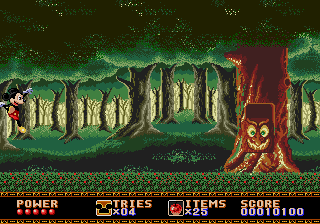

You will easily be able to collect the minimum required, but if you want to collect everything and unlock Achievements or Trophies you’ll need to do a lot of trial and error and go back to re-play stages in order to find everything. To progress through the Castle to more advanced levels Mickey must collect regular gems, of which there are many in each stage. This is especially the case when it comes to the in-game collectables. The regular platforming sections have been built with a lot of care and planning, which results in some clever level design and some really taxing platform action. These sections are quite fun, but are really just short diversions from the two dimensional meat of the game, and that is no bad thing. This is one of the few points in the game where the pace actually slows down from frantic to something a little more relaxed – albeit only for a few minutes. The third dimension is very cleverly used in the Clock Tower level, as part of a mirror-based puzzle. Other stages might see you casually walking in 2D, before a huge apple starts to chase you – a la Raiders of the Lost Ark – and the view switches to a face on chase, which is hugely reminiscent of the early Crash Bandicoot games. Here you can freely explore in three dimensions. You first encounter it when, after a short side-scrolling forest section, you arrive at the Castle world hub. Where the levels differ are the points where the game moves from 2D into 3D. You have to implement great timing and precision to make inch-perfect jumps and avoid enemy fire, falling platforms and other obstacles.

The levels also play out in similar ways, despite the general structure having been re-worked. Your main method of defeating bad guys is the good old noggin bounce, but players can also hurl apples and, later on, candles for a ranged attack, just as in the original game. Mickey can perform a regular jump, that suffices most of the time, but can also gain extra air by bouncing off the head of an enemy, to be propelled upward. The basic gameplay has been left unchanged since the first game, but perhaps tweaked a little for modern audiences. Of course, if the player has to re-play sections they have failed repeatedly they will hear some of the same commentary repeated, but this isn’t much of an issue as this is the only time there is any repetition. Because the delivery is so serious, it lends itself to a knowing, sardonic wit – and when the jokes do come they are largely pretty successful. He also commentates on proceedings as we go along, commiserating when something goes awry, but also adding in some humorous lines along the way. But it is the ever-present narrator who leaves more of a mark on the game – for the better.įirstly, he acts as a guide, introducing new levels as we reach them and giving a little idea of what to expect. These are all short, but help nudge the story along a little bit without becoming intrusive. The cutscenes vary from hand-drawn still images in a traditional Disney style, to fully 3D ones. This is achieved largely through the use of short cutscenes and a narrator. Although, it must be said that the narrative thread running through the game is much more coherent and successful than the first game. Of course, the story wasn’t incredibly compelling when the game was first released, and it isn’t the most important factor this time around either. Only with the seven gems can Mickey create the Rainbow bridge that will lead to Mizrabel’s tower, and his final battle. With that, Mickey sets out to rescue the damsel in distress and learns he must defeat several Masters of Illusion – creatures working for Mizrabel who guard the seven Rainbow Gems.

The story remains entirely the same, though, as our hero Mickey’s true love Minnie is kidnapped by the wicked Witch Mizrabel (the antagonist from Snow White), who wants to steal Minnie’s youth in order to restore her own. Although many factors and features remain from the original 1991 game, SEGA Studios Australia have used that title as a jumping-off point.

Whereas Duck Tales was exactly what it said on the box, a re-mastering complete with updated graphics and sound but maintaining the gameplay and level structure of the original, the developers who put together Castle of Illusion take a little more creative freedom with their game. Of course, one of these was developed by Capcom and the other by SEGA, but Disney itself must have some interest in re-living the past glories of the company in video game form. Disney seem to be on somewhat of a retro kick lately, what with the recently-released DuckTales Remastered and now this – a re-imagining of classic MegaDrive title Castle of Illusion Starring Mickey Mouse.


 0 kommentar(er)
0 kommentar(er)
